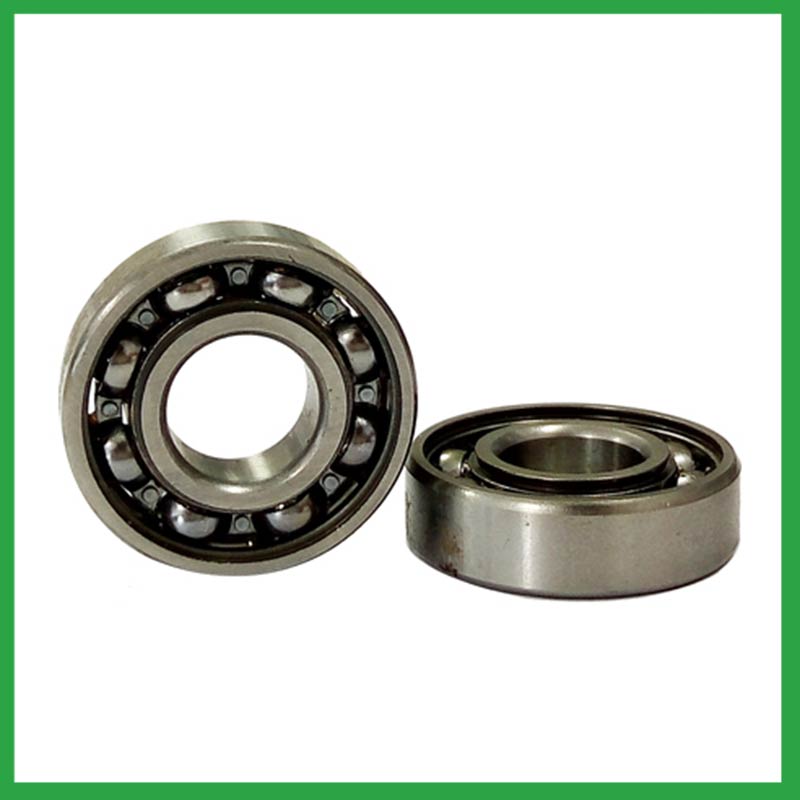PRODUCTS
CONTACT US
Ningbo Nide International Co., Ltd.
一一
· Contact person:Jack Zeng
· Mob/Whatspp/WeChat:0086-13738869026
· Email:emarketing@nide-group.com;marketing4@nide-group.com
· Add:No. 169, Wohushan Road, Daqi Subdistrict, Beilun District, Ningbo, China

Nide team could manufacture ball bearing as per customer’s drawing and samples.
If customer only has samples, we could also design drawing fo r our customer.
We also provide customized service.
Our ball bearing is widely applied the different industrials.
Haishu Nide International Co., Ltd is located in Ningbo City, Zhejiang Province. It is a high-tech enterprise that integrates research and development, application, production, and sales. Mainly producing high-performance ball bearing,thermal protector,shaft,fan,insulation paper,carbon brush, etc. The product has a series of characteristics such as oil-free self-lubricating, wear resistance, corrosion and rust resistance, acid, alkali, salt and gas corrosion resistance, no magnetic and electrical insulation, high temperature and cold resistance, light weight, etc. It is widely used in industries such as compress motor,servo motor,single and three phase induction motor,washing machine motor,water pump motor,BLDC motor,fan motor,electric bicycle motor.
By ceaselessly improve our quality and, our products win high praise for our favorable price, excellent service and timely delivery. No matter before or after sales, from quality to price, we have the complete and professional management system.

| Parameter | Information |
| Product Name | ball bearing cpu fan |
| Brand Name | Nide |
| Place of Origin | Ningbo,Zhejiang,China |
| Type | Ball |
| Material | ceramics, etc. |
| Sample | Avaible |
| Warranty | 3months-1year |
| Lubrication | Dry/ Oil |
| Application | textile machinery, etc. |
| Port | Ningbo/Shanghai |
| Size(mm) | customize |
| Export Country | Argentina,Brazil,South Korea,Reunion,Netherlands Antilles,Panama,Niger,Falkland Islands...etc |
| Export region | Africa,Oceania,America... |
| Certification | ISO 9001 Certification,CE-stator coil lacing machine,ISO9001:2015 certificate,etc |
| Precision Rating | as per customer's requirement |
| Feature | Low Noise,Good wear resistance...etc |
| Packaging Details | Suitable for sea transportation |
| Color | Silver gray+customized |
| Seals Type | Rubber seals |
| Service | Prompt Delivery |
| Supply Ability | 100000-500000 Piece/Pieces per Month |
| Lead time (days) | 15-20 (To be negotiated) |
Please note: The above table data is for reference only. For specific information, please contact us.
ball bearing cpu fan require thrust for installation, which can be achieved by using a combination ring made of steel sleeve and transmission rubber, or by using an adjustment plate to tighten the bolt to form a combination ring installation structure.
During the installation process, pollution from dirt and wear media should be prevented;
Temperature and humidity should be controlled to avoid excessive temperatures during startup and operation;
It should be operated and lubricated in the correct reverse direction to avoid unnecessary damage.
Ball bearings have many advantages, making them highly competitive in the market.
Firstly, they are very durable and have good wear performance, making their service life longer than many other types of bearings.
Secondly, they are easy to install and can provide low friction performance in various applications.
Thirdly, they require a relatively low level of maintenance, making them cost-effective.
In addition, compared to many other types of bearings, their purchase cost is relatively low, making them an economical choice.




ball bearing cpu fan---FAQs Guide
2.What are the common materials used in ball bearing cpu fan manufacturing?
3.Can ball bearing cpu fan operate in high-speed applications, and what design features make them suitable for such conditions?
4.Can ball bearing cpu fan operate in high-temperature environments like industrial ovens or furnaces, and how are they protected from heat-related damage?
5.What is a ball bearing?
6.What is the significance of ball bearing cpu fan lubrication, and how does it affect bearing lifespan and performance?
7.How do ball bearing cpu fan provide smooth and controlled motion in various mechanical systems, such as conveyor belts or automobiles?
8.What is the typical noise level associated with ball bearing cpu fan, and how are noise-reduction techniques applied?
9.How do manufacturers address concerns related to bearing noise and vibration in sensitive equipment?
10.Can ball bearing cpu fan be customized with special coatings or treatments to meet specific industry standards or regulatory requirements?
11.Are there self-aligning ball bearing cpu fan that accommodate misalignment and shaft deflection in rotating equipment?
12.What are the advancements and innovations in ball bearing cpu fan technology that have emerged in recent years?
13.How do sealed ball bearing cpu fan prevent the ingress of contaminants and extend the bearing's service life?
1.As a ball bearing cpu fan manufacturer,How Can We Guarantee Quality?
Always a Pre-production Sample Before Mass Production;Always Final Inspection Before Shipment.
2.What are the common materials used in ball bearing cpu fan manufacturing?
Most ball bearing cpu fan are made of a type of steel known as high carbon chromium steel, often called chrome steel. This is used for reasons of cost and durability. Bearings are also made from other materials such as stainless steel, ceramics and plastic.
3.Can ball bearing cpu fan operate in high-speed applications, and what design features make them suitable for such conditions?
They have very low rolling friction and are optimized for low noise and low vibration. This makes them ideal for high-speed applications. ball bearing cpu fan are comparatively easy to install and require minimal maintenance.
4.Can ball bearing cpu fan operate in high-temperature environments like industrial ovens or furnaces, and how are they protected from heat-related damage?
ball bearing cpu fan are capable of working at temperatures up to +842°F (+450 °C). Special lubricants, seals and coatings make this possible by protecting the ball bearings from heat damage.

5.What is a ball bearing?
A ball bearing is a type of rolling-element bearing that uses balls to maintain the separation between the bearing races.
The purpose of a ball bearing is to reduce rotational friction and support radial and axial loads. It achieves this by using at least two races to contain the balls and transmit the loads through the balls. In most applications, one race is stationary and the other is attached to the rotating assembly (e.g., a hub or shaft). As one of the bearing races rotates it causes the balls to rotate as well. Because the balls are rolling they have a much lower coefficient of friction than if two flat surfaces were sliding against each other.
Ball bearings tend to have lower load capacity for their size than other kinds of rolling-element bearings due to the smaller contact area between the balls and races. However, they can tolerate some misalignment of the inner and outer races.
6.What is the significance of ball bearing cpu fan lubrication, and how does it affect bearing lifespan and performance?
Bearing lubrication is vital for preserving the performance and lifespan of rolling element bearings. Lubrication helps separate moving parts relative to one another, such as rollers and raceways or balls, to prevent wear and tear and friction.
7.How do ball bearing cpu fan provide smooth and controlled motion in various mechanical systems, such as conveyor belts or automobiles?
In essence, ball bearing cpu fan operate on the principle that it's far more efficient to roll over surfaces than to slide, thereby significantly reducing friction and facilitating smooth movement of machinery parts.
8.What is the typical noise level associated with ball bearing cpu fan, and how are noise-reduction techniques applied?
To measure in accurate way the ball bearing cpu fan noise under rotation during their manufacturing process is a key activity particularly in the production of medium, small and ultra-small deep groove ball bearings. This capability in bearings noise analysis has become the real distinguishing element between a standard bearings noise equipment and a superior class one.
The various types of vibration and sound in rolling bearings can be grouped in four main categories: structural, manufacturing, handling and other. The structural vibration consists mostly of race, click, squeal and cage noise: it can be continuous or intermittent depending on specific cases. The manufacturing vibration is instead related to the waviness noise generated by the geometrical imperfections of inner and outer ring and of rolling elements, being always continuous in nature. The so-called handling vibration is normally associated with flaw and contamination and is generating – in most of the cases – irregular noise. Then there are other types of vibrabition that include noise generated by sealing and lubricant (irregular) or by runout (continuous).

9.How do manufacturers address concerns related to bearing noise and vibration in sensitive equipment?
From a ball bearing cpu fan manufacturing perspective, a low noise or vibration rating is achieved by paying attention to the surface finish of the raceways and balls, their roundness, and selecting the correct cage design. Finely filtered low noise greases can also be used to reduce vibrations.
10.Can ball bearing cpu fan be customized with special coatings or treatments to meet specific industry standards or regulatory requirements?
Yes, ball bearing cpu fan can be customized with special coatings or treatments to meet specific industry standards or regulatory requirements.
1. Corrosion-resistant coatings: These coatings are used to protect the bearings from corrosion caused by exposure to moisture, chemicals, and other corrosive substances.
2. High-temperature coatings: These coatings are used to improve the thermal stability and performance of bearings in high-temperature environments.
3. Food-grade coatings: These coatings are specially designed for applications in the food and beverage industry, where bearings come into contact with food, beverage, or pharmaceutical products.
4. Anti-static and non-conductive coatings: These coatings are used to dissipate static electricity, which can cause damage to electronic components.
5. Specialized lubrication treatments: Bearings can be treated with specialized lubricants that meet specific industry standards or regulatory requirements.
11.Are there self-aligning ball bearing cpu fan that accommodate misalignment and shaft deflection in rotating equipment?
These ball bearing cpu fan are particularly suitable for applications where misalignment can arise from errors in mounting or shaft deflection. A variety of designs are available with cylindrical and taper bores, with seals and adapter sleeves and extended inner rings.
12.What are the advancements and innovations in ball bearing cpu fan technology that have emerged in recent years?
Significant advancements have been made in ball bearing cpu fan steels over the years. Modern, ultra-clean bearing steels contain fewer and smaller non-metallic particles, giving ball bearings greater resistance to contact fatigue.

13.How do sealed ball bearing cpu fan prevent the ingress of contaminants and extend the bearing's service life?
Contact seals are a type of seal where the sealing lip physically touches the inner raceway of the ball bearing cpu fan. They create a narrow line or zone of contact that forms a barrier to prevent the escape of lubricants and the ingress of contaminants. Because the seal keeps dirt and other contaminants out, it can offer a longer operating life of the bearing or prevent premature bearing failure. Sealed bearings can be considered lubricated for life, which eliminates the need for a relubrication process.

